Abstract
Although catalase is thought to be a major defense against hydrogen peroxide (H2O2), the catalase activity within individual Escherichia coli fails to protect against exogenous H2O2. Contrary to earlier reports, we find that dilute suspensions of wild-type and catalase-deficient E. coli are identical in their sensitivity to H2O2, perhaps because even wild-type, catalase-positive E. coli cannot maintain an internal/external concentration gradient of this highly diffusible oxidant. However, concentrated suspensions or colonies of catalase-positive E. coli do preferentially survive H2O2 challenge and can even cross-protect adjacent catalase-deficient organisms. Furthermore, high-density catalase-positive--but not catalase-negative--E. coli can survive and multiply in the presence of competitive, peroxide-generating streptococci. These observations support the concept that bacterial catalase may defend colonial, but not individual, E. coli against environmental H2O2. Group protection by the activity of enzymes that mitigate oxidative stress may have been a driving force in the evolution of multicellular organisms.
Full text
PDF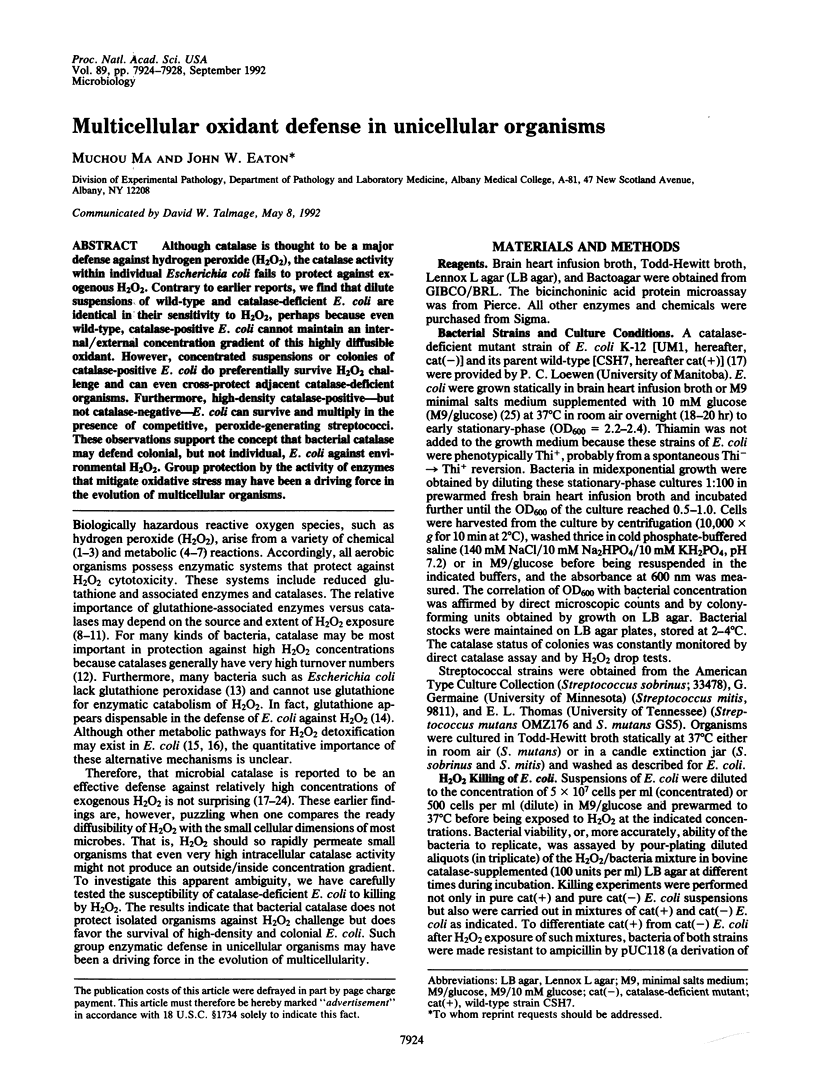
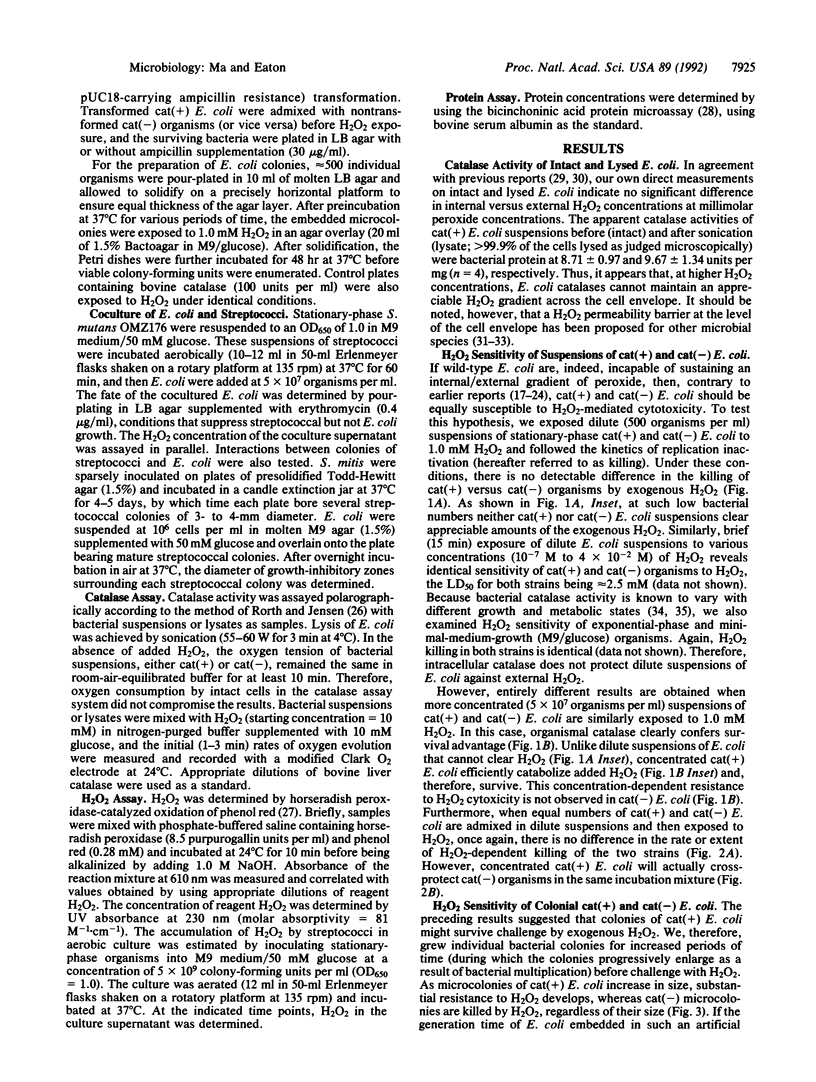
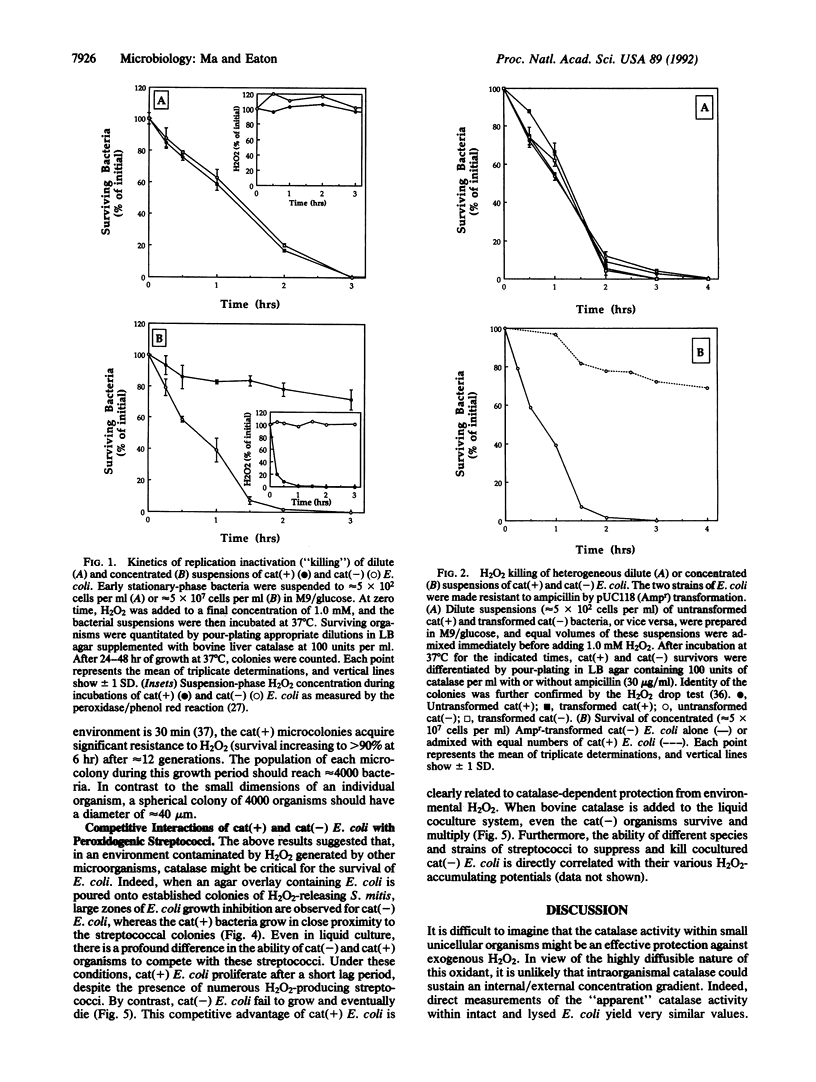
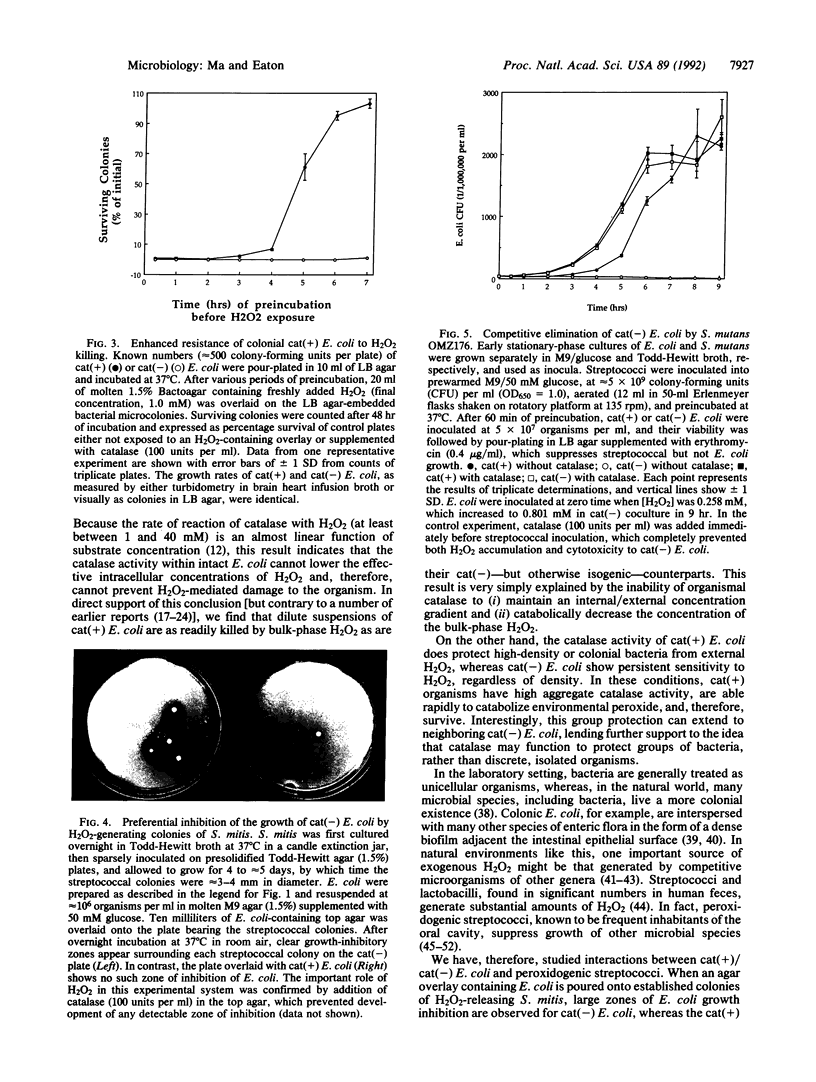
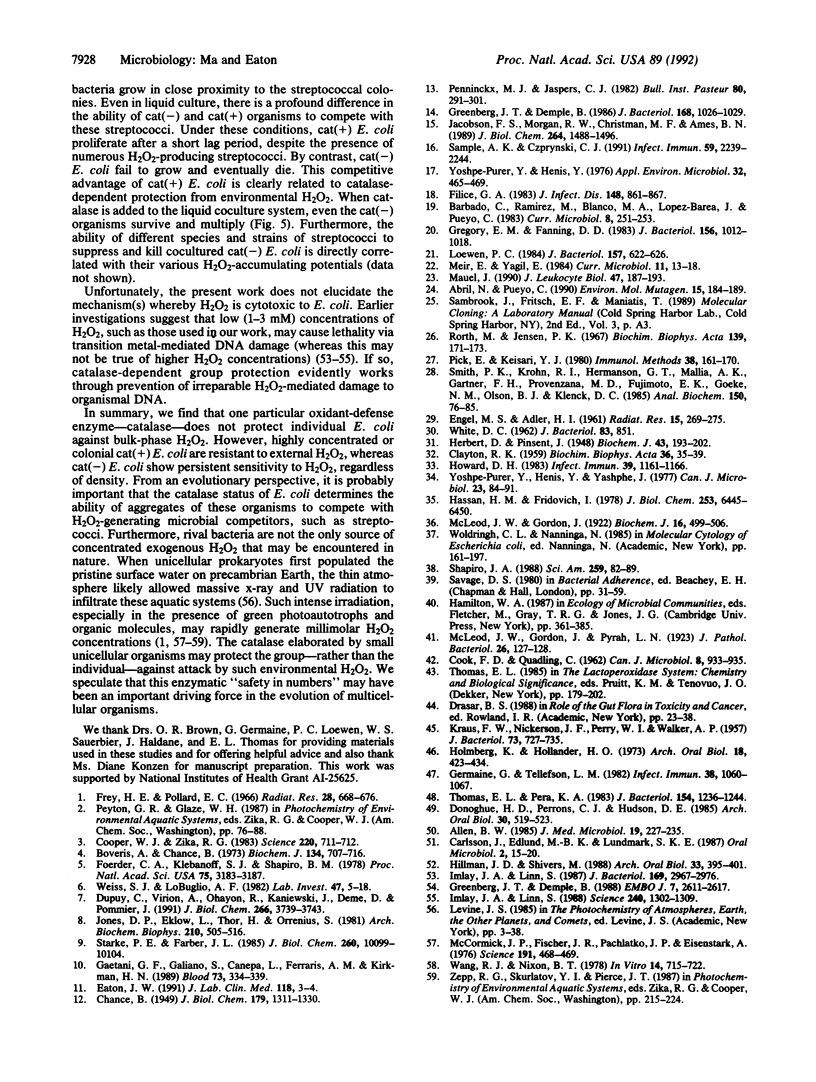
Images in this article
Selected References
These references are in PubMed. This may not be the complete list of references from this article.
- Abril N., Pueyo C. Mutagenesis in Escherichia coli lacking catalase. Environ Mol Mutagen. 1990;15(4):184–189. doi: 10.1002/em.2850150403. [DOI] [PubMed] [Google Scholar]
- Allen B. W. In-vitro inhibition of mycobacteria by viridans streptococci. J Med Microbiol. 1985 Apr;19(2):227–235. doi: 10.1099/00222615-19-2-227. [DOI] [PubMed] [Google Scholar]
- Boveris A., Chance B. The mitochondrial generation of hydrogen peroxide. General properties and effect of hyperbaric oxygen. Biochem J. 1973 Jul;134(3):707–716. doi: 10.1042/bj1340707. [DOI] [PMC free article] [PubMed] [Google Scholar]
- CLAYTON R. K. Permeability barriers and the assay of catalase in intact cells. Biochim Biophys Acta. 1959 Nov;36:35–39. doi: 10.1016/0006-3002(59)90066-6. [DOI] [PubMed] [Google Scholar]
- Carlsson J., Edlund M. B., Lundmark S. K. Characteristics of a hydrogen peroxide-forming pyruvate oxidase from Streptococcus sanguis. Oral Microbiol Immunol. 1987 Mar;2(1):15–20. doi: 10.1111/j.1399-302x.1987.tb00264.x. [DOI] [PubMed] [Google Scholar]
- Cooper W. J., Zika R. G. Photochemical formation of hydrogen peroxide in surface and ground waters exposed to sunlight. Science. 1983 May 13;220(4598):711–712. doi: 10.1126/science.220.4598.711. [DOI] [PubMed] [Google Scholar]
- Donoghue H. D., Perrons C. J., Hudson D. E. The role of H2O2 and the lactoperoxidase-SCN(-)-H2O2 system on the interaction between two bacteria originating from human dental plaque, Streptococcus rattus (mutans) BHT and Streptococcus mitior LPA-1, grown on human teeth in an artificial mouth. Arch Oral Biol. 1985;30(7):519–523. doi: 10.1016/0003-9969(85)90051-2. [DOI] [PubMed] [Google Scholar]
- Dupuy C., Virion A., Ohayon R., Kaniewski J., Dème D., Pommier J. Mechanism of hydrogen peroxide formation catalyzed by NADPH oxidase in thyroid plasma membrane. J Biol Chem. 1991 Feb 25;266(6):3739–3743. [PubMed] [Google Scholar]
- ENGEL M. S., ADLER H. I. Catalase activity, sensitivity to hydrogen peroxide, and radiation response in the genus Escherichia. Radiat Res. 1961 Sep;15:269–275. [PubMed] [Google Scholar]
- Eaton J. W. Catalases and peroxidases and glutathione and hydrogen peroxide: mysteries of the bestiary. J Lab Clin Med. 1991 Jul;118(1):3–4. [PubMed] [Google Scholar]
- Filice G. A. Resistance of Nocardia asteroides to oxygen-dependent killing by neutrophils. J Infect Dis. 1983 Nov;148(5):861–867. doi: 10.1093/infdis/148.5.861. [DOI] [PubMed] [Google Scholar]
- Foerder C. A., Klebanoff S. J., Shapiro B. M. Hydrogen peroxide production, chemiluminescence, and the respiratory burst of fertilization: interrelated events in early sea urchin development. Proc Natl Acad Sci U S A. 1978 Jul;75(7):3183–3187. doi: 10.1073/pnas.75.7.3183. [DOI] [PMC free article] [PubMed] [Google Scholar]
- Frey H. E., Pollard E. C. Ionizing radiation and bacteria: nature of the effect of irradiated medium. Radiat Res. 1966 Jul;28(3):668–676. [PubMed] [Google Scholar]
- Gaetani G. F., Galiano S., Canepa L., Ferraris A. M., Kirkman H. N. Catalase and glutathione peroxidase are equally active in detoxification of hydrogen peroxide in human erythrocytes. Blood. 1989 Jan;73(1):334–339. [PubMed] [Google Scholar]
- Germaine G. R., Tellefson L. M. Glucose uptake by Streptococcus mutans, Streptococcus mitis, and Actinomyces viscosus in the presence of human saliva. Infect Immun. 1982 Dec;38(3):1060–1067. doi: 10.1128/iai.38.3.1060-1067.1982. [DOI] [PMC free article] [PubMed] [Google Scholar]
- Greenberg J. T., Demple B. Glutathione in Escherichia coli is dispensable for resistance to H2O2 and gamma radiation. J Bacteriol. 1986 Nov;168(2):1026–1029. doi: 10.1128/jb.168.2.1026-1029.1986. [DOI] [PMC free article] [PubMed] [Google Scholar]
- Greenberg J. T., Demple B. Overproduction of peroxide-scavenging enzymes in Escherichia coli suppresses spontaneous mutagenesis and sensitivity to redox-cycling agents in oxyR-mutants. EMBO J. 1988 Aug;7(8):2611–2617. doi: 10.1002/j.1460-2075.1988.tb03111.x. [DOI] [PMC free article] [PubMed] [Google Scholar]
- Gregory E. M., Fanning D. D. Effect of heme on Bacteroides distasonis catalase and aerotolerance. J Bacteriol. 1983 Dec;156(3):1012–1018. doi: 10.1128/jb.156.3.1012-1018.1983. [DOI] [PMC free article] [PubMed] [Google Scholar]
- Hassan H. M., Fridovich I. Regulation of the synthesis of catalase and peroxidase in Escherichia coli. J Biol Chem. 1978 Sep 25;253(18):6445–6420. [PubMed] [Google Scholar]
- Herbert D., Pinsent J. Crystalline bacterial catalase. Biochem J. 1948;43(2):193–202. doi: 10.1042/bj0430193. [DOI] [PMC free article] [PubMed] [Google Scholar]
- Hillman J. D., Shivers M. Interaction between wild-type, mutant and revertant forms of the bacterium Streptococcus sanguis and the bacterium Actinobacillus actinomycetemcomitans in vitro and in the gnotobiotic rat. Arch Oral Biol. 1988;33(6):395–401. doi: 10.1016/0003-9969(88)90196-3. [DOI] [PubMed] [Google Scholar]
- Holmberg K., Hallander H. O. Production of bactericidal concentrations of hydrogen peroxide by Streptococcus sanguis. Arch Oral Biol. 1973 Mar;18(3):423–434. doi: 10.1016/0003-9969(73)90167-2. [DOI] [PubMed] [Google Scholar]
- Howard D. H. Studies on the catalase of Histoplasma capsulatum. Infect Immun. 1983 Mar;39(3):1161–1166. doi: 10.1128/iai.39.3.1161-1166.1983. [DOI] [PMC free article] [PubMed] [Google Scholar]
- Imlay J. A., Linn S. DNA damage and oxygen radical toxicity. Science. 1988 Jun 3;240(4857):1302–1309. doi: 10.1126/science.3287616. [DOI] [PubMed] [Google Scholar]
- Imlay J. A., Linn S. Mutagenesis and stress responses induced in Escherichia coli by hydrogen peroxide. J Bacteriol. 1987 Jul;169(7):2967–2976. doi: 10.1128/jb.169.7.2967-2976.1987. [DOI] [PMC free article] [PubMed] [Google Scholar]
- Jacobson F. S., Morgan R. W., Christman M. F., Ames B. N. An alkyl hydroperoxide reductase from Salmonella typhimurium involved in the defense of DNA against oxidative damage. Purification and properties. J Biol Chem. 1989 Jan 25;264(3):1488–1496. [PubMed] [Google Scholar]
- Jones D. P., Eklöw L., Thor H., Orrenius S. Metabolism of hydrogen peroxide in isolated hepatocytes: relative contributions of catalase and glutathione peroxidase in decomposition of endogenously generated H2O2. Arch Biochem Biophys. 1981 Sep;210(2):505–516. doi: 10.1016/0003-9861(81)90215-0. [DOI] [PubMed] [Google Scholar]
- KRAUS F. W., NICKERSON J. F., PERRY W. I., WALKER A. P. Peroxide and peroxidogenic bacteria in human saliva. J Bacteriol. 1957 Jun;73(6):727–735. doi: 10.1128/jb.73.6.727-735.1957. [DOI] [PMC free article] [PubMed] [Google Scholar]
- Loewen P. C. Isolation of catalase-deficient Escherichia coli mutants and genetic mapping of katE, a locus that affects catalase activity. J Bacteriol. 1984 Feb;157(2):622–626. doi: 10.1128/jb.157.2.622-626.1984. [DOI] [PMC free article] [PubMed] [Google Scholar]
- Mann J. M., Chin J., Piot P., Quinn T. The international epidemiology of AIDS. Sci Am. 1988 Oct;259(4):82–89. doi: 10.1038/scientificamerican1088-82. [DOI] [PubMed] [Google Scholar]
- Mauël J. Macrophage-parasite interactions in Leishmania infections. J Leukoc Biol. 1990 Feb;47(2):187–193. doi: 10.1002/jlb.47.2.187. [DOI] [PubMed] [Google Scholar]
- McCormick J. P., Fischer J. R., Pachlatko J. P., Eisenstark A. Characterization of a cell-lethal product from the photooxidation of tryptophan: hydrogen peroxide. Science. 1976 Feb 6;191(4226):468–469. doi: 10.1126/science.1108203. [DOI] [PubMed] [Google Scholar]
- McLeod J. W., Gordon J. Production of Hydrogen Peroxide by Bacteria. Biochem J. 1922;16(4):499–506. doi: 10.1042/bj0160499. [DOI] [PMC free article] [PubMed] [Google Scholar]
- Pick E., Keisari Y. A simple colorimetric method for the measurement of hydrogen peroxide produced by cells in culture. J Immunol Methods. 1980;38(1-2):161–170. doi: 10.1016/0022-1759(80)90340-3. [DOI] [PubMed] [Google Scholar]
- Rorth M., Jensen P. K. Determination of catalase activity by means of the Clark oxygen electrode. Biochim Biophys Acta. 1967 May 16;139(1):171–173. doi: 10.1016/0005-2744(67)90124-6. [DOI] [PubMed] [Google Scholar]
- Sample A. K., Czuprynski C. J. Elimination of hydrogen peroxide by Haemophilus somnus, a catalase-negative pathogen of cattle. Infect Immun. 1991 Jul;59(7):2239–2244. doi: 10.1128/iai.59.7.2239-2244.1991. [DOI] [PMC free article] [PubMed] [Google Scholar]
- Smith P. K., Krohn R. I., Hermanson G. T., Mallia A. K., Gartner F. H., Provenzano M. D., Fujimoto E. K., Goeke N. M., Olson B. J., Klenk D. C. Measurement of protein using bicinchoninic acid. Anal Biochem. 1985 Oct;150(1):76–85. doi: 10.1016/0003-2697(85)90442-7. [DOI] [PubMed] [Google Scholar]
- Starke P. E., Farber J. L. Ferric iron and superoxide ions are required for the killing of cultured hepatocytes by hydrogen peroxide. Evidence for the participation of hydroxyl radicals formed by an iron-catalyzed Haber-Weiss reaction. J Biol Chem. 1985 Aug 25;260(18):10099–10104. [PubMed] [Google Scholar]
- Thomas E. L., Pera K. A. Oxygen metabolism of Streptococcus mutans: uptake of oxygen and release of superoxide and hydrogen peroxide. J Bacteriol. 1983 Jun;154(3):1236–1244. doi: 10.1128/jb.154.3.1236-1244.1983. [DOI] [PMC free article] [PubMed] [Google Scholar]
- WHITE D. C. Cytochrome and catalase patterns during growth of Haemophilus parainfluenzae. J Bacteriol. 1962 Apr;83:851–859. doi: 10.1128/jb.83.4.851-859.1962. [DOI] [PMC free article] [PubMed] [Google Scholar]
- Wang R. J., Nixon B. R. Identification of hydrogen peroxide as a photoproduct toxic to human cells in tissue-culture medium irradiated with "daylight" fluorescent light. In Vitro. 1978 Aug;14(8):715–722. doi: 10.1007/BF02616168. [DOI] [PubMed] [Google Scholar]
- Weiss S. J., LoBuglio A. F. Phagocyte-generated oxygen metabolites and cellular injury. Lab Invest. 1982 Jul;47(1):5–18. [PubMed] [Google Scholar]
- Yoshpe-Purer Y., Henis Y. Factors affecting catalase level and sensitivity to hydrogen peroxide in Escherichia coli. Appl Environ Microbiol. 1976 Oct;32(4):465–469. doi: 10.1128/aem.32.4.465-469.1976. [DOI] [PMC free article] [PubMed] [Google Scholar]



